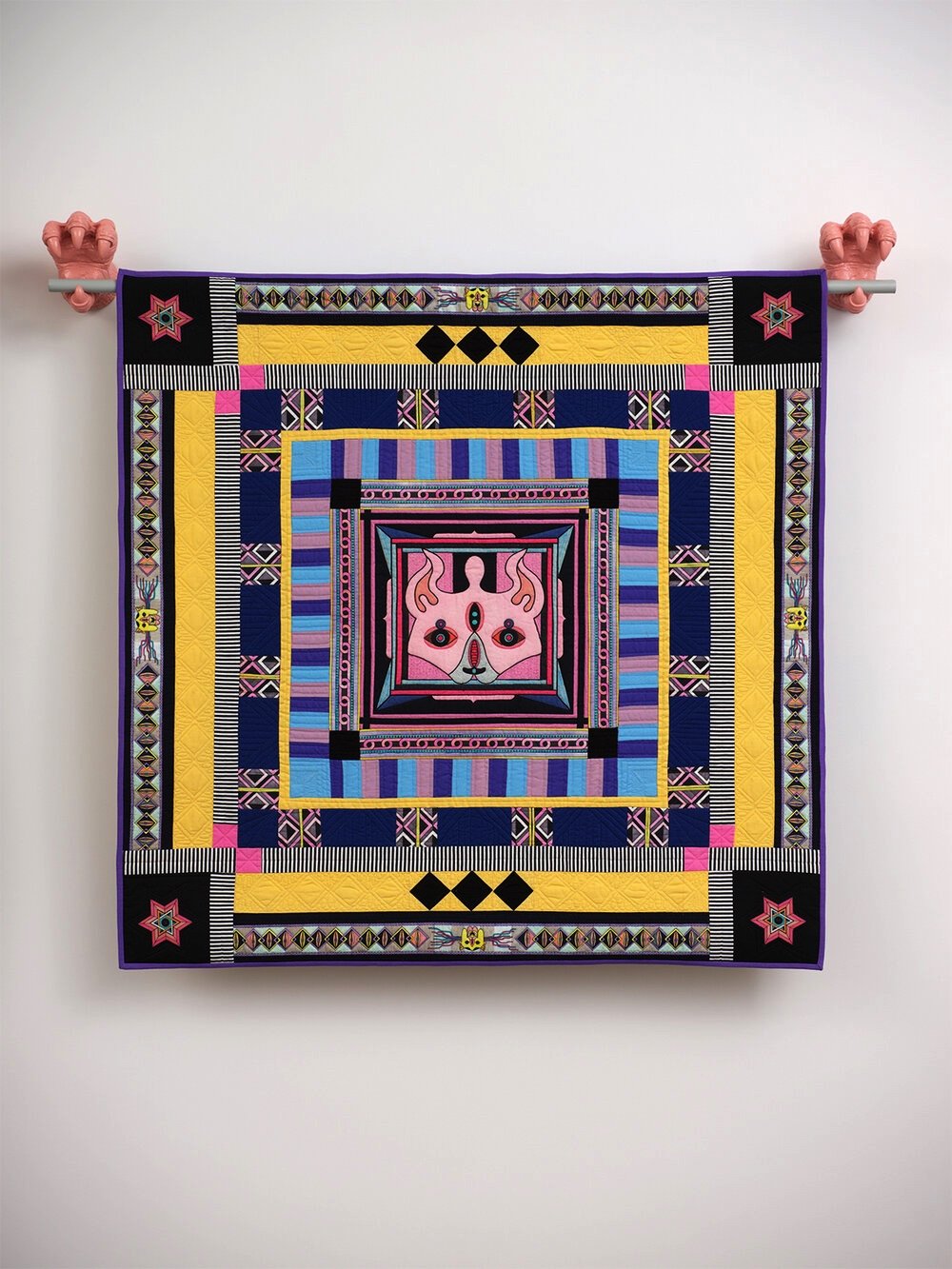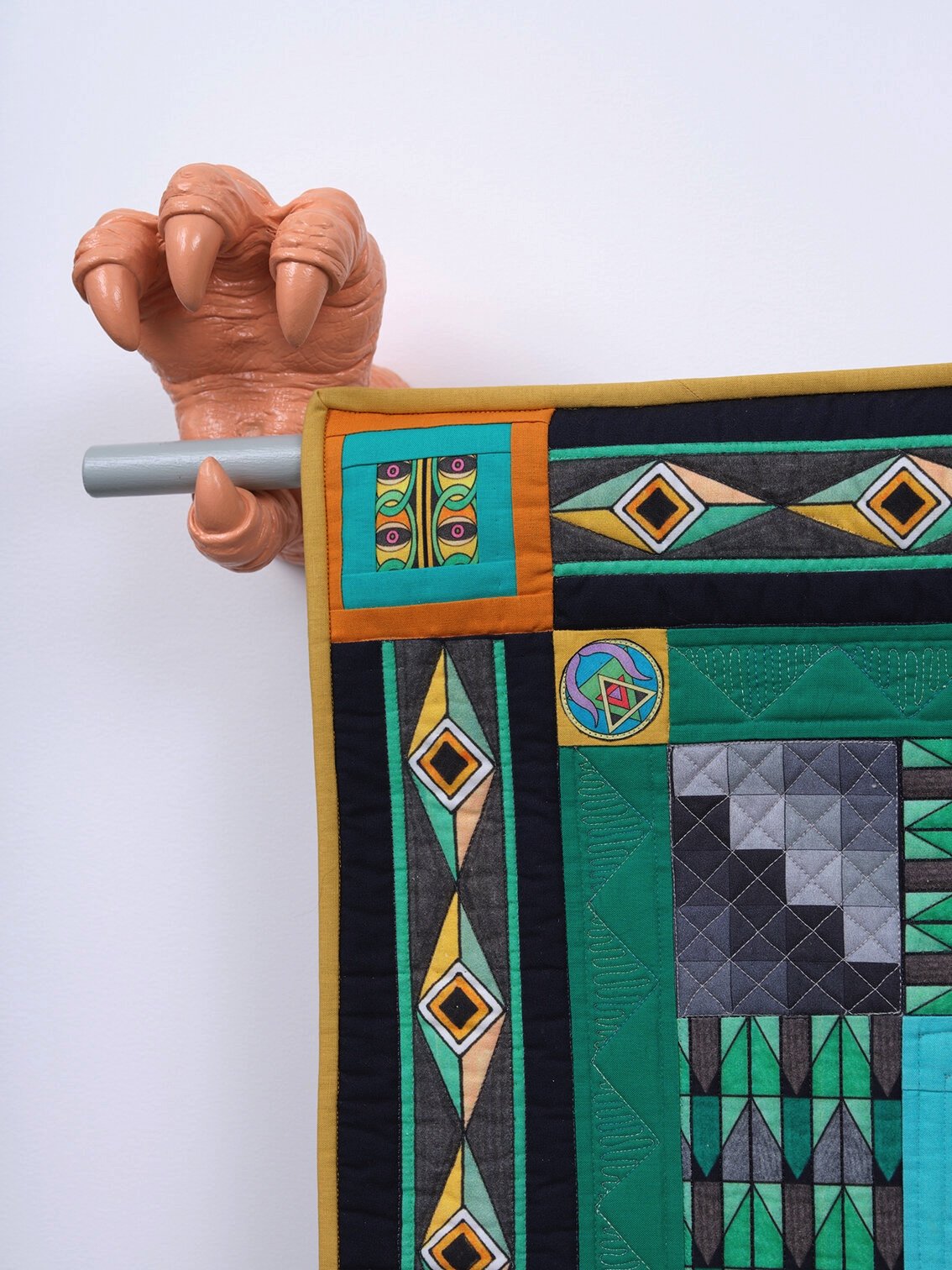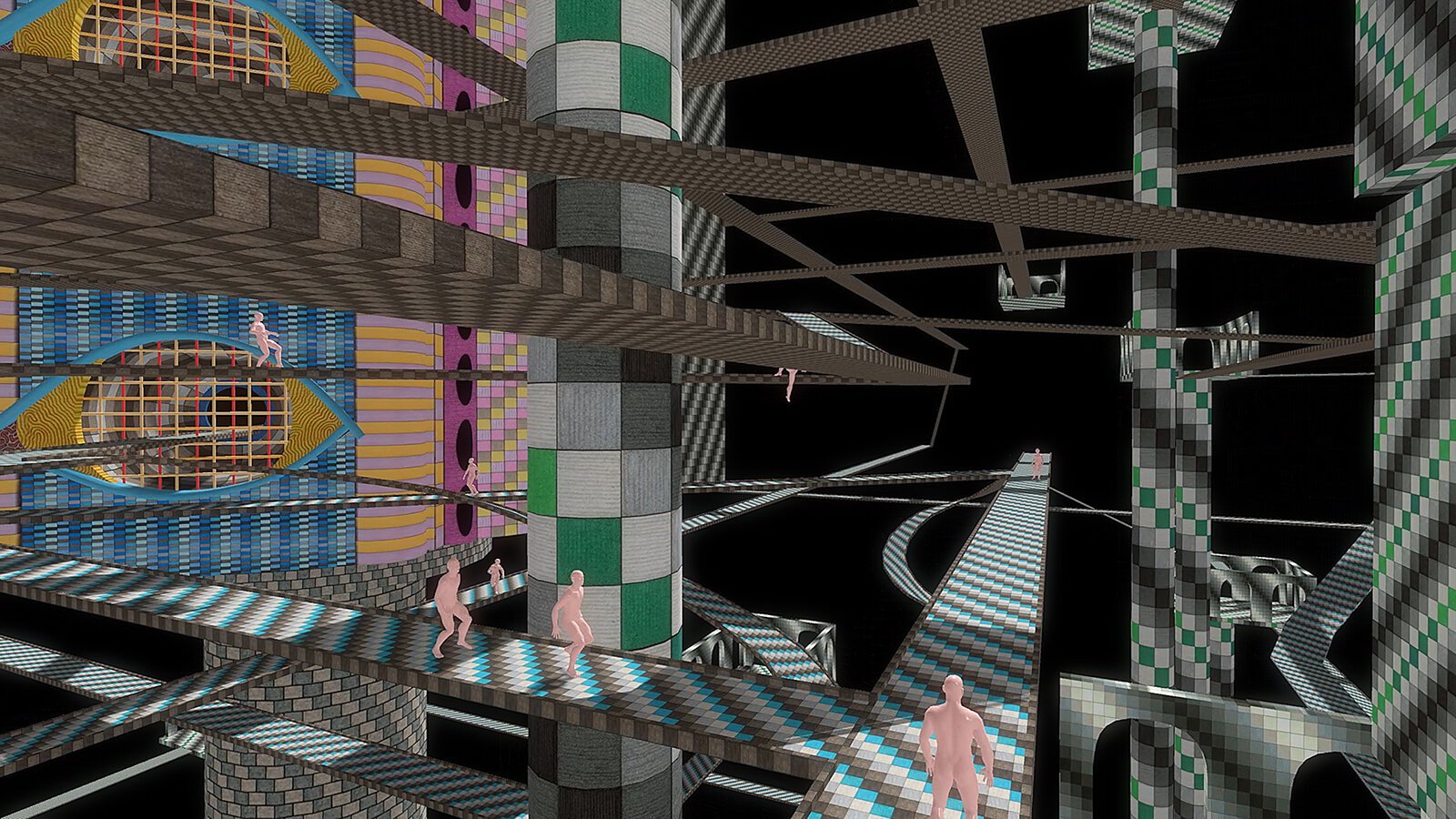Prophet of the Wurm: an interview with Jess Johnson
Jess Johnson, Rat in the Skull, 2020, pen, fibre tipped markers, acrylic paint and gouache on paper, 56 x 76 cm
Maya Love: A very important interview question to start with: Tell me about your cats.
Jess Johnson: I’ve got a new foster hiding under my bed, he might come out.
Is he the one playing with the pens?
No, I found a home for that one. That was Little Pea and she was very adoptable so she was only here for three weeks. I got a new one a few days ago, he's an old senior boy with trust issues—my favourite type of cat. I think he’d been shuffled around a bunch of foster homes that were too noisy for him and he was going downhill. He’s very timid and has a quirk where he needs to be sat with and stroked while he eats, otherwise, he won't.
He needs a bit of help.
Yeah, to get him back to health. He’s cross-eyed too.
You cared for cats in Brooklyn too. How did that come about?
At the start of 2020, I moved to Redhook, a small industrial neighbourhood in Brooklyn by the sea. They have a big stray cat population that came about because of Hurricane Sandy. It got smashed because it's right on the water and when people evacuated, they left their pets behind. Now there are these populations of semi-feral, semi-domesticated pets who have congregated together, mostly in old, abandoned lots—sort of disused automotive yards.
It sounds like a dystopic Pixar cartoon.
At the start of the pandemic, I’d go on regular walks around the neighbourhood and started noticing and befriending some of the cats. I spoke to the neighbours and found that their feeder had left New York, so I started feeding them on my own bat. I soon met others who cared for the local street cans and were involved in trap-neuter-release (TNR), which helped keep the cat population under control. It became my whole life during Covid.
It’s a wholesome focus.
Of course, it's also quite time-consuming—regular feeding, trapping, worrying about them, getting vet attention and what have you. A friend, Bobby moved in with me and he's an absolute cat-obsessive too, so we shared the load. But it was getting expensive, so I did a fundraiser print for the trucker cats. From that, I raised enough to keep my colony fed for the next nine months and donate to a bunch of people self-funding TNR in local neighbourhoods. We’re still in a Whatsapp group with the new carers, so I get regular updates. When I got to Aotearoa/New Zealand I started fostering through the SPCA and I’m using my Instagram to help rehome them.
Jess Johnson, May We Live Long and Die Out, 2020, pen, fibre tipped markers, acrylic paint and gouache on paper, 105.5 x 75 cm
Jess Johnson, If They Cry Feed Them More, 2020, pen, fibre tipped markers, acrylic paint and gouache on paper, 38 x 28 cm
Jess Johnson, Unspeakable Freedom Device, 2020, pen, fibre tipped markers, acrylic paint and gouache on paper, 111.8 x 75 cm
It’s a bittersweet focus compared to the rest of what was going on in New York—
It kept me absolutely sane—I couldn’t control all the chaos happening in the world, but I could make life better for this small community of animals in the truck lot.
Do you find a sense of control in your drawing?
Yeah. I would say I’m very controlling and I channel that control into my drawings and career. I like that I’m in charge of my own time and the way I make money—I don’t have to answer to or rely on anyone else. I structure my days the way I want. I have complete control over the world in my drawings and am master of that universe.
Are you quite ritualistic with your drawing?
I think I would be adrift without drawing to structure my days around. When I was younger, I had a lot of compulsions, probably unhealthy ones, but they were all bouncing off in different directions. My life was very chaotic. I think drawing gave this one focus where I could channel everything and then all the other parts of my life became easier, calmer. Control is a big part of it.
On the flip side, it's also exhilarating for me to relinquish control and I get to do that through collaborations. I’m strict with myself in being quite hands-off with my collaborators, because if I get too involved I’ll naturally try to wrest control back and micromanage their work which grinds the process to a halt. I’m still learning how to work with Simon and it’s been several years now. It’s walking that line between control and chaos—the tension between the two impulses is where the good stuff happens.
Managed chaos.
Yeah. If it veers too much toward rigid methodology, it becomes cold and digital; and if it goes too far toward chaotic, then it loses itself in organic noodling as well. It's important to me to indulge both impulses.
Jess Johnson and Cynthia Johnson, Alwasy, 2021, quilt made from digital print on cotton with pieced fabric border, assorted textiles, thread, 145 x 140 cm
Jess Johnson and Cynthia Johnson, Teep (detail), 2021, quilt made from digital print on cotton with pieced fabric border, assorted textiles, thread, 85.5 x 78 cm
On the topic of collaborations, I know you love Susan Te Kahurangi King. Have you been watching her work with Auckland Print Studio?
Oh my god, yes! I’ve been loving those videos that show her actively drawing. It is so lyrical how she’ll move across the page. It’s fucking wonderful. I tend to vortex into an area and force myself to pull back—but the way she so fluidly shifts from one area of the page to another, it's like she's singing a song to herself. Most of the work I'm attracted to by other people is raw, unedited…
Free-flowing.
Yeah, people send me work that reminds them of mine, and I find it quite repulsive in its similarity. There’s just something in my own rigidity that I’m repelled by. I’m sure if I had an objective eye, I wouldn’t be a fan of my own work. It’s just so uptight
The internal narrative of your world is free-flowing, there’s no existing chronology. Instead, it’s little snapshots and relics, moments where time diverges and leaks into alternate universes.
Yeah, I like that. There’s a fancy word I read once—temporal—or something like that. I take it to mean time and gravity all stretching out in different directions.
You’ve mentioned Raëlism in interviews before. What’s that about?
Oh god. Yes. I’ll try to abbreviate this. When I was younger, I used to vortex into things, get really obsessed, kind of manic over one subject and then move on. So for a couple of years I was very obsessed with this artist Paul Laffoley, and in trying to decipher all the cryptic codexes of his work. I came across an interview with him in a zine where he recounted this story of his grandfather, who had always told him stories about being visited by aliens. His grandfather gave him a gift of a medallion which he said the aliens had given him, and Paul wore this from then on. He went to France in his twenties and on a drinking spree and befriended a man in a bar. They spent the evening together and passed out in a park. When Paul awoke the next morning, the man was gone and so was his medallion. Years later, Paul is watching an exposé on a new UFO cult called the Raëlians. One of their tenants is when humans have evolved enough to clone themselves, that will signal to the alien overlords who seeded earth, that we're advanced enough for them to return and anoint us with the secrets of the universe (or something like that). They start to interview the leader of the cult and Paul recognises him as the man he'd gotten drunk with all these years earlier and he's wearing his grandfather’s medallion around his neck, whose symbol has been adopted as the Raelian’s own.
Wild.
I don’t know, I think I have one of those minds that try too hard to find patterns and connections in things. It can send me down odd wormholes.
Paul Laffoley, Thanaton III, 1989, oil, acrylic, letraset and ink on canvas, 186.7 x 186.7 cm
You often talk about taking inspiration from books, comics, films. I heard you used to make gig posters. What kind of music are we talking about?
In my twenties, I did a bit of travel before settling in Melbourne where I set up this art/music space called Hell Gallery in Richmond. I ran it with my ex-partner Jordan Marani, who lived on this rambling compound of falling-down, brick buildings, full of ad-hoc art studios and bedsits. We were both working as freelance installers at large institutions, so we had access to building materials and scraps that would get skipped at the end of exhibition builds. We were both hoarders, so we would stockpile a bunch of weird stuff.
Stuff you’re going to use, one day.
We gutted the ground floor and built this perfect little white cube of a gallery with all the salvaged materials. We’d throw a big party once a month for the exhibition opening and we’d built this little side room with a stage where we’d host bands, DJs and performances. For every exhibition, I’d do a hand-drawn poster—it was kind of the way I got back into drawing. I’d go down to Officeworks and photocopy all the posters, go to all the art spaces and venues, and distribute them around town. Sometimes I’d go to house parties and use the toilet and see all my fliers on the walls, which was incredibly validating to me. There was a lot of music/art crossover at Hell Gallery. A lot of the artists that we’d show would play in bands, so their band might play at the opening. One of the first shows we did was with Brendan Huntly, the singer of Eddy Current Suppression Ring, who were on a massive ascent in popularity. Boomgates and Deaf Wish played there, Super Wild Horses and Terror of the Deep from New Zealand. I think Hell Gallery ran for about four years. I’ve always liked the poster archive; it documents this specific slither of Melbourne’s art and music scene.
The whole period. Do you still have the archive?
The gallery started getting some attention and we started selling works. We got invited to do Hell Gallery at other places: a project in Tasmania, some regional galleries and we’d do this travelling ‘hell road show’. The Hell posters were the first sale I ever made. It was to this Sydney collector called Amanda Love. I’d never framed anything before and when I costed it, I was like
Both: Fuck.
Can’t afford that.
I got all these cheap frames and mounted them all myself. I gave them all to her for a set price. It would have been a pittance, but it was exciting for me because she was a big collector and it was my first sale. The originals are in her collection, wherever that is. I’ve got all the photocopies.
Digital hoarding. The best kind.
When Hell wrapped up, I had a bit of burnout from install work and running the space, so I decided to take a year off. I was going to draw full-time and just see how it went.
Jess Johnson, Martin Bell From The Fourth Dimension Book Launch Poster, 2011
Jess Johnson, ALL MY FRIENDS ARE MONSTERS Exhibition Poster, 2009
Lo and behold.
Beyond exhibiting and selling works, you have an impressive catalogue of merch. T-shirts, tote bags, skateboards, flash tattoos—I heard a set of playing cards are in the pipeline?
I really like cards and their designs. That’s a future thing I’d like to do.
Your Gamejackers* seem like they’d use a set of cards.
*Long fingered creatures who feature in Webwurld (2017), tempting fate in a rhythmic game.
When I first started travelling overseas and going to the big galleries and museums in Europe, I’d always go to the gift shop and buy a postcard and a tote bag of the show. I loved all the art paraphernalia and souvenirs. It was those mementos that I could afford and how I’d connect. When I first started selling my work commercially it quickly got to the point where I couldn’t afford to own one of my drawings. A lot of the people that are into my work, you know, there’s a lot of teenagers. They just want a poster for their wall.
Less of the classic ‘art crowd’.
I like being able to provide affordable stuff and I think my work translates easily into different mediums. I like that it gives me a little autonomy and income independent of the commercial gallery scene. It's the stuff I'd buy if I was into the work of an artist.
When I arrived in America, financially things were pretty tenuous before I started selling work. There’s less of an attitude toward artists having other commercial ventures in America, than there is in New Zealand and Australia.
Damned if you do, damned if you don’t.
Yeah exactly. Most people wouldn’t bat an eye over there about selling T-shirts as it’s accepted that everyone needs some kind of side hustle just to survive. I mean, it’s New York.
Jess Johnson, Milxyz Pips, 2020, pen, fibre tipped markers, acrylic paint and gouache on paper, 380 x 280 mm
Everyone’s got bills to pay. You’ve said before that it felt like a way forward during Covid—no one knew what the dealer gallery model was going to look like.
I’ve always felt the art world is fickle. I’ve never operated with the assumption that I’m going to keep being able to make a viable income from my drawings, so I’ve always had my fingers in lots of different pots. Collaborations, little commercial jobs, my work with Simon and animation. I like to have diversified income. It feels arbitrary that the art world decided to legitimize the work that I do, when it’s basically science-fiction illustration, meanwhile most of the artists whose work I love are comic artists. You’d never see their work in galleries. They just post it on Instagram, make zines, sell t-shirts. They don’t get the validation from the art world but their work is as legitimate as mine. Equally, a lot of the people who like my work aren't going to galleries at the weekend, they just found my work on Instagram. They're into gaming and film and sci-fi. My work in the art world is just one tangent. I think I've got more people into my work from those other spheres than from the art world.
Jess Johnson and Simon Ward, Terminus: A virtual reality experience in five parts [Realm One, Fleshold Crossing], 2018
Jess Johnson and Simon Ward, Terminus: A virtual reality experience in five parts [Realm Two, Known Unknown], 2018
Jess Johnson and Simon Ward, Terminus: A virtual reality experience in five parts [Realm Three, Scumm Engine], 2018
Jess Johnson and Simon Ward, Terminus: A virtual reality experience in five parts [Realm Four, Gog + Magog], 2018
Jess Johnson and Simon Ward, Terminus: A virtual reality experience in five parts [Realm Five, Tumblewych], 2018
You did a residency at Driving Creek recently, and now you’re working with clay.
I want to continue that, but I haven't had the workspace for it. I love it. I didn't even start that until the final week of the residency, otherwise, we were working on the short film and making NFTs.
And searching for critters.
Stalking the neighbouring farm cat.
Soon, you’re curating a ceramics exhibition at Te Uru. Was that a direct result of Driving Creek?
(Laughs) I have no idea how the pottery thing came about. If it traces back to this, it’s kind of ridiculous but I like it. I’d never worked with pottery or clay, but when I arrived in New Zealand and went through quarantine, I was in Christchurch. I let an old art school friend, Jacquelyn Greenbank, know I was in town, and she dropped me off a gift package. I think she was trolling me, but it was like…
A kilo of clay…
Yeah. I had no idea what to do with it. I was on Instagram too much because I was bored, and people started sending me suggestions on what to make with the clay. Someone suggested Weetbix and they were about my skill level, so I started making them. Then I progressed to making a giant Weetbix. I got a few comments like, ‘oh you’re doing ceramics now, great!’ Here I am, like, ‘okay sure.’ Then Te Uru got in touch because I was supposed to be having a show there as part of my McCahon House Residency (2018) and they suggested I curate a ceramics show. Even during Driving Creek, I told them I don't know much about clay, ‘can my collaborator come and work on our short film,’ and they were like, 'Sure, but we'll give you some pottery lessons too.’ It's as if the universe wants me to be a potter now.
Should we expect any clay ‘fleshsuits’?
No, I don’t think so. I’m making an environment to house the ceramics inspired by my favourite filmic references: the Crystal Chamber in Dark Crystal, Hellraiser. I’m going to design some flooring vinyl, wallpaper and gothic pedestals with dramatic lighting. That’ll be my contribution, and the artists—Janet Beckhouse, Emily Hunt, Rose Salmon, Nichola Shanley and Laurie Steer—are thankfully on board with it too.
Love it.















